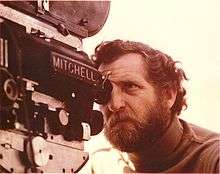Kent L. Wakeford
| Kent L. Wakeford | |
|---|---|
 | |
| Born |
Kent Lon Wakeford January 23, 1928 Los Angeles, California, U.S |
| Occupation | Cinematographer, television commercial producer |
| Years active | 1965–1998 |
Kent Lon Wakeford (born 1928) is an American cinematographer, the co-founder of Wakeford / Orloff Productions and founder of Kent Wakeford and Associates, two commercial production companies.
Wakeford is most known for working on Martin Scorsese's films Mean Streets and Alice Doesn't Live Here Anymore, as well as on the films Some Folks Call It a Sling Blade[1] and Wedding Bell Blues.
Early life and career
Wakeford was born in 1928 and grew up in south Los Angeles. While finishing up high school, Wakeford apprenticed with fashion photographer Earl Scott. Following his apprenticeship, Wakeford landed a job as a cameraman at The Douglas Aircraft Company. There he was responsible for filming new missiles, planes, and classified weapons tests at White Sands New Mexico and Edwards Air Force Base, becoming one of the early experts in super high speed cinema (5,000 to 8,000 frames per second). Wakeford’s work at The Douglas Aircraft Company led him to the United States Army where Kent spent two years in the Signal Corp. as a motion picture cameraman in New York City and Germany.[2]
Following his time in the Army, Wakeford began shooting documentary films. One of his early documentary films was on Wernher von Braun whom Wakeford had met and developed a relationship with at Douglas Aircraft. He furthered his documentary career by shooting films with Willard Van Dyke, a leading social documentary filmmaker who later went on to be director of the Department of Film at the Museum of Modern Art.[3]
Advertising career
To supplement his documentary work, Wakeford began freelancing on commercial projects. One of his first jobs was as a cameraman for “Danger is My Business”, a reality show that traveled around California filming dangerous professions. During this time, he also created art films, including “Fish” which explored movement of color in synch to music and won an award at the Edinburgh International Film Festival.[4]
Later Wakeford began shooting live action that would be incorporated into animation. Wakeford quickly began working for animators in Hollywood like Jose Cuauhtemoc “Bill” Malendez (Peanuts), Hanna & Barbera, among others. With this success, Wakeford started a commercial production company with John Orloff called Wakeford / Orloff Productions. Wakeford/Orloff Productions shot national commercials for brands including Budweiser, Mattel, Hot Wheels, Barbie, Boeing, Purina, Post Cereal, Chevrolet, United Airline, Maybeline, Max Factor, Procter & Gamble, Rice o Roni, Gallo Wine, Kellogs, and McDonalds.[5][6]
Film career
Wakeford's first major motion picture was Mean Streets (1973) directed by Martin Scorsese and starring Harvey Keitel and Robert De Niro. Wakeford shot the film using handheld camera techniques to capture the self-destructive lives of shady characters in Little Italy New York. The Huffington Post called the cinematography by Wakeford "arguably the most original for this genre at the time and has been copied endlessly in other movies, down to his audacious tracking shots. The innovative handholding and lighting techniques used by Wakeford have since become mainstream practice in American cinema." In 1997, the United States National Film Registry elected to preserve Mean Streets for being "culturally, historically, or aesthetically significant."[7]
_and_Kent_L._Wakeford_(Cinematographer).jpg)
Wakeford went on to shoot Alice Doesn’t Live Here Anymore (1974) directed by Martin Scorsese and starring Ellen Burstyn and Kris Kristofferson. The National Board of Review of Motion Pictures called Wakeford's cinematography "inventive." The film won the Academy Award for Best Actress (Ellen Burstyn) and was nominated for an Academy Award for Best Actress in a Supporting Role for Diane Ladd and Best Writing, Original Screenplay for Robert Getchell.[8]
Kent later transitioned back into commercial work by starting production company Kent Wakeford & Associates.
He later spent a season shooting the television show L.A. Law. However, after 14 episodes he turned his attention to small independent films and shot over a dozen independent films over the next decade. Most of the films were action oriented using his gritty street-like sensibility from Mean Streets. He has also shot short films such as the This Ain't Bebop segment of Imagining America directed by Ralph Bakshi and starring Harvey Keitel and Ron Thompson.[9]
Filmography
- Halfway Home (1998)
- Waking Up Horton (1997)
- Last Lives (1996)
- Wedding Bell Blues (1996)
- Power 98 (1996)
- Boy Crazy, Girl Crazier (1996)
- Loser (1994)
- Frame-Up II: The Cover-Up (1994)
- Some Folks Call It a Sling Blade (1993)
- Love, Cheat & Steal (1993)
- Grey Knight (1992)
- Ironheart (1992)
- Hold Me, Thrill Me, Kiss Me (1992)
- Night Eyes II (1991)
- Total Exposure (1991)
- The Last Hour (1991)
- China O'Brien II (1990)
- China O'Brien (1990)
- This Ain't Bebop (1989)
- L.A. Law (TV series) (1987–1988)
- The Women's Club (1987)
- The Princess Academy( 1987)
- Alice Doesn't Live Here Anymore (1974)
- Black Belt Jones (1973)
- Doctor Death: Seeker of Souls (1973)
- Mean Streets (1973)
References
- ↑ "Some Folks Call It a Sling Blade". The New York Times.
- ↑ British Federation of Film Societies (2001). Film. British Federation of Film Societies.
- ↑ Moma.org
- ↑ American Society of Cinematographers (1975). American Cinematographer. ASC Holding Corp.
- ↑ Bessie, Dan; Jeff (2006). Reeling Through Hollywood. Untreed Reads.
- ↑ Goldrich (2011-11-04). "Industry Mourns Chuck Sloan". Shoot Online. Retrieved 19 July 2011.
- ↑ Angard (2009-09-02). "Kent Wakeford: Redefining American Cinematography in "Mean Streets"". The Huffington Post. Retrieved 19 July 2011.
- ↑ National Board of Review of Motion Pictures (1975). Films in review, Vol 26. National Board of Review of Motion Pictures.
- ↑ "Kent Wakeford Filmography". The New York Times.
External links
| Wikimedia Commons has media related to Kent L. Wakeford. |